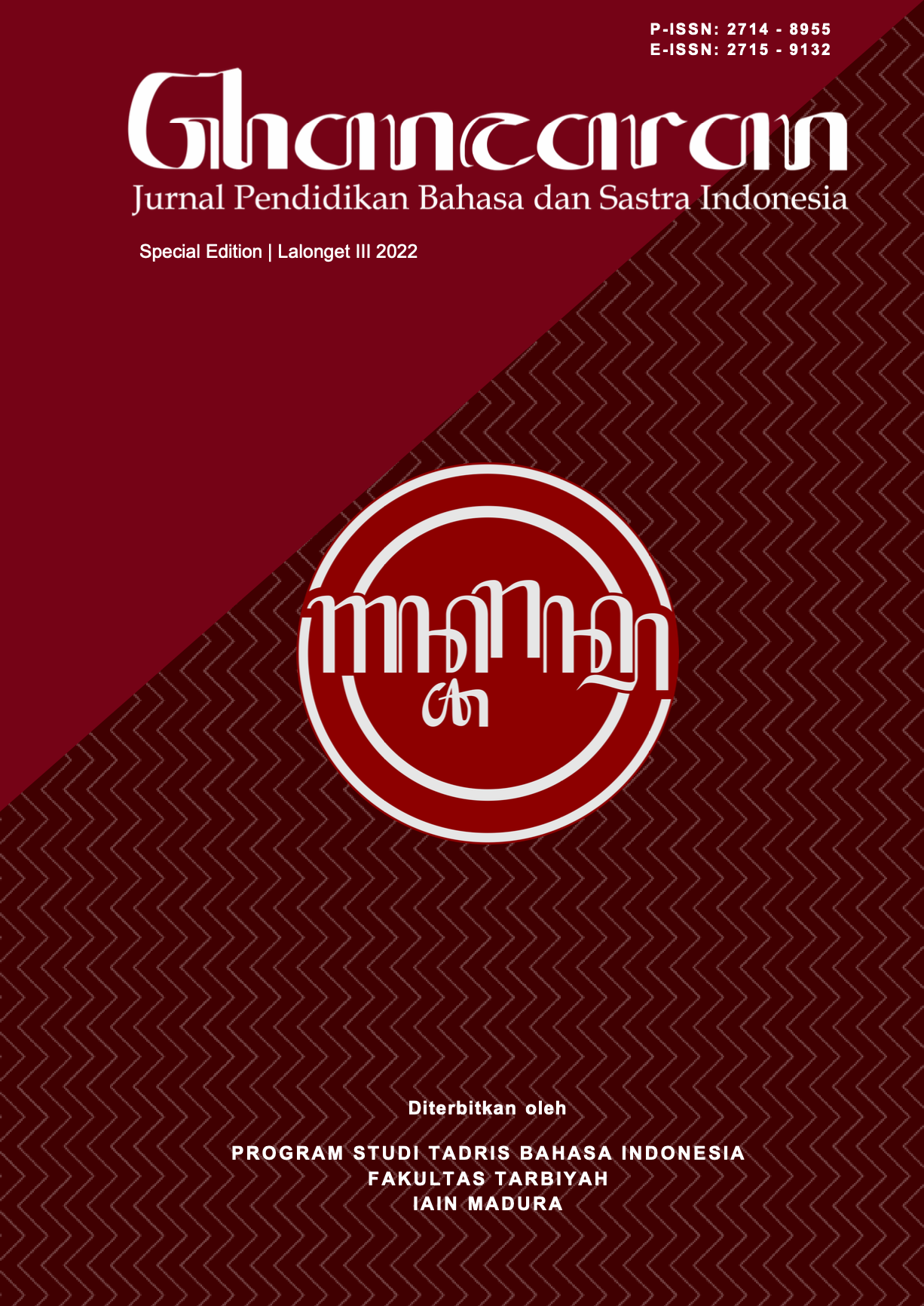Menyingkap Religiositas Hikayat Hang Tuah Melalui Penggunaan Kosakata Islamiah: Kajian Manuskrip Sastra Pendidikan pada Era Merdeka Belajar
 Abstract views: 390
,
Abstract views: 390
,
 PDF downloads: 792
PDF downloads: 792
Abstract
Hikayat Hang Tuah is actually written in Arabic-Malay script. In addition, the vocabulary used in it is not a little that comes from Arabic. The romance of Islamic Malay culture also seems thick in every story. Thus, it is interesting to conduct a study whose purpose is to describe the form of Islamic Malay/Islamic Malay cultured vocabulary in terms of lexical and grammatical meanings and to describe the religiosity of the vocabulary in the Hikayat Hang Tuah. This research uses qualitative research with philological research approach. The data from this study are the results of the researchers' notes, in the form of vocabulary and entries that form the background of the vocabulary in the saga. While the source of data in this study is the Hikayat Hang Tuah I in 2010 published by the Language Center of the Ministry of National Education. The instrument used in this research is a vocabulary classification guide as well as a rubric for collecting and analyzing data. The results of the study revealed that there were at least 77 data found based on lexical and grammatical meanings. This meaning then shows the existence of Islamic religiosity in the form of Islamic faith which is still influenced by the existence of gods, honorifics of the king which states that the king is a descendant of gods and "representatives of God" in the world and litotes on figures who have lower degrees, work related to religion. Islam, the authority of the king, the equation, and the typical expression of the hikayat.
Downloads
References
Braginsky, V. I. (1990). Hikayat Hang Tuah; Malay epic and muslim mirror; Some considerations on its date, meaning and structure. Bijdragen Tot de Taal-, Land- En Volkenkunde / Journal of the Humanities and Social Sciences of Southeast Asia, 146(4), 399–412.
Chaer, Abdul. (2009). Pengantar Semantik Bahasa Indonesia. Rineka Cipta.
Chaer, Abdul. (2012). Linguistik Umum. Rineka Cipta.
Dewi, Wendi Widya Ratna. (2009). Semantik Bahasa Indonesia. Intan Pariwara.
Hamdan, R., & Radzi, S. B. Md. (2013). The Concept of Happiness of the Malay Hero Hang Tuah: 2013 International Conference on the Modern Development of Humanities and Social Science, Hong Kong. https://doi.org/10.2991/mdhss-13.2013.70
Hamzah, Z. A. Z., & Hassan, A. F. M. (2011). Bahasa dan Pemikiran dalam Peribahasa Melayu. 11, 21.
KBBI Daring. (n.d.). Retrieved November 26, 2022, from https://kbbi.kemdikbud.go.id/entri/Arkais
Keraf, G. (1991). Tata Bahasa Bahasa Indonesia. Grasindo.
Kridalaksana, H. (2008). Kamus Linguistik. Gramedia.
Mamat, M. A. (2017). [Malay Manuscrpt in Islamic Education: A Preliminary Study in The National Library of Malaysia] Manuskrip Melayu dalam Bidang Pendidikan Islam: Suatu Kajian Awal di Perpustakaan Negara Malaysia. Jurnal Islam Dan Masyarakat Kontemporari, 15(1), 61–83.
Muhammad Nida Fadlan. (2020, June). Global Pandemic, It’s Time to Read Old Manuscripts from Home! –
Parera, J. D. (2004). Teori Semantik (2nd ed.). Erlangga.
Saeed, J. D. (2004). Semantics. Blackwell Publishers.
Said, K. M. (2007). Minda Orientalis dan Minda Pasca-Kolonial: Politik Membaca Hikayat Hang Tuah. Akademika.
Saputra, F. I. G., Priyadi, A. T., & Wartiningsih, A. (n.d.). Kajian Strukturaliame dan Nilai-Nilai pada Hikayat Hang Tuah Jilid I Karya Muhammad Haji Saleh. 14.
Shihab, M. Q. (2020). Kosakata Keagamaan. Lentera Hati.
Shofwani, M. I. (2005). Mengenal Tulisan Arab-Melayu. Adicita.
Thamrin, H. (2018). Antropologi Melayu. Kalimedia.
Wellek, R., & Warren, A. (2016). Teori Kesusastraan (Terjemahan Melani Budianta). Gramedia.
Wijk, D. G. V. (1909). Tata Bahasa Melayu. Djambatan.
Wulandari, R., Rijadi, A., & Widjajanti, A. (2020). Kata Arkais pada Hikayat Hang Tuah I dan Pemanfaatannya sebagai Alternatif Materi Pembelajaran Bahasa Indonesia di SMA Kelas X. BELAJAR BAHASA: Jurnal Ilmiah Program Studi Pendidikan Bahasa dan Sastra Indonesia, 5(1), 25–38. https://doi.org/10.32528/bb.v5i1.2445
Zakaria, I. (2012). Islam dan Falsafahnya dalam Kebudayaan Melayu. 18.
Zubair, D. K. M. A. A. (n.d.). Arwi Script of Tamil Language and Jawi Script of Malay Language: Script as Religious Entity and Cultural Heritage | Think India Journal.
Copyright (c) 2022 GHANCARAN: Jurnal Pendidikan Bahasa dan Sastra Indonesia

This work is licensed under a Creative Commons Attribution-ShareAlike 4.0 International License.
Ghancaran: Jurnal Pendidikan Bahasa dan Sastra Indonesia uses an Open Access Policy under the Creative Commons Attribution-ShareAlike 4.0 International License. Authors publishing in this journal agree to the following terms:
- Ghancaran Journal holds the copyright and grants the journal rights for first publication with the work simultaneously licensed under a

The work is distributed under Creative Commons Attribution-ShareAlike 4.0 International License which allows others to share, copy, and redistribute the material in any media or format and adapt, remix, change, and develop the material even for commercial purposes, as long as it is stated credit and license derivative works under similar terms. - Authors may make additional contractual arrangements for non-exclusive distribution of the journal's published work version.
- Authors are permitted to post their work online (e.g., in institutional repositories or on their websites) before and during submission, as doing so may lead to productive exchange.


















